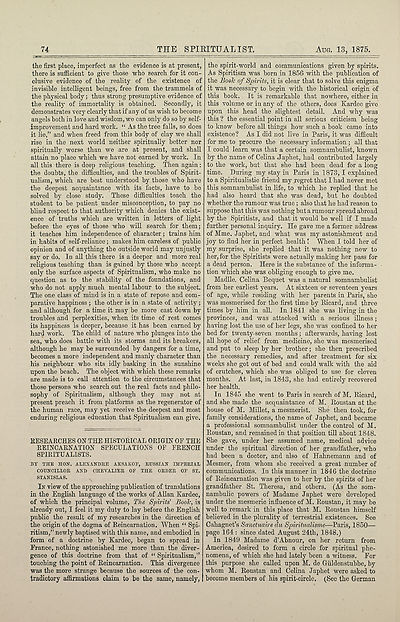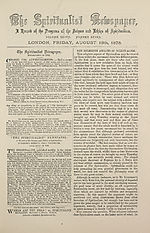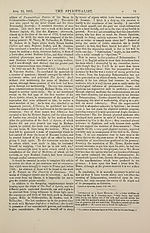Download files
Complete book:
Individual page:
Thumbnail gallery: Grid view | List view

74
THE SPIRITUALIST.
Aug. 13, 1875.
the first place, imperfect as the evidence is at present,
there is sufficient to give those who search for it con¬
clusive evidence of the reality of the existence of
invisible intelligent beings, free from the trammels of
the physical body; thus strong presumptive evidence of
the reality of immortality is obtained. Secondly, it
demonstrates very clearly that if any of us wish to become
angels both in love and wisdom, we can only do so by self-
improvement and hard work. “ As the tree falls, so does
it lie,” and when freed from this body of clay we shall
rise in the next world neither spiritually better nor
spiritually worse than we are at present, and shall
attain no place which we have not earned by work. In
all this there is deep religious teaching. Then again:
the doubts, the difficulties, and the troubles of Spirit¬
ualism, which are best understood by those who have
the deepest acquaintance with its facts, have to be
solved by close study. These difficulties teach the
student to be patient under misconception, to pay no-
blind respect to that authority which denies the exist¬
ence of truths which are written in letters of light
before the eyes of those who will search for them;
it teaches him independence of character; trains him
in habits of self-reliance; makes him careless of public
opinion and of anything the outside world may unjustly
say or do. In all this there is a deeper and more real
religious teaching than is gained by those who accept
only the surface aspects of Spiritualism, who make no
question as to the stability of the foundations, and
who do not apply much mental labour to the subject.
The one class of mind is in a state of repose and com¬
parative happiness; the other is in a state of activity;
and although for a time it may be more cast down by
troubles and perplexities, when its time of rest comes
its happiness is deeper, because it has been earned by
hard work. The child of nature who plunges into the
sea, who does battle with its storms and its breakers,
although he may be surrounded by dangers for a time,
becomes a more independent and manly character than
his neighbour who sits idly basking in the sunshine
upon the beach. The object with which these remarks
are made is to call attention to the circumstances that
those persons who search out the real facts and philo¬
sophy of Spiritualism, although they may not at
present preach it from platforms as the regenerator of
the human race, may yet receive the deepest and most
enduring religious education that Spiritualism can give.
RESEARCHES ON THE HISTORICAL ORIGIN OF THE
REINCARNATION SPECULATIONS OF FRENCH
SPIRITUALISTS.
BT THE HON. ALEXANDKE AKSAKOE, RUSSIAN IMPERIAL
COUNCILLOR AND CHEVALIER OP THE ORDER OE ST.
STANISLAS.
In view of the approaching publication of translations
in the English language of the works of Allan Kardec,
of which the principal volume, The Spirits' Boole, is
already out, I feel it my duty to lay before the English
public the result of my researches in the direction of
the origin of the dogma of Reincarnation. When “ Spi¬
ritism,” newly baptised with this name, and embodied in
form of a doctrine by Kardec, began to spread in
France, nothing astonished me more than the diver¬
gence of this doctrine from that of “ Spiritualism,”
touching the point of Reincarnation. This divergence
was the more strange because the sources of the con¬
tradictory affirmations claim to be the same, namely,
the spirit-world and communications given by spirits.
As Spiritism was born in 1856 with the publication of
the Boole of Spirits, it is clear that to solve this enigma
it was necessary to begin with the historical origin of
this book. It is remarkable that nowhere, either in
this volume or in any of the others, does Kardec give
upon this head the slightest detail. And why was
this ? the essential point in all serious criticism being
to know before all things how such a book came into
existence? As I did not live in Paris, it was difficult
for me to procure the necessary information; all that
I could learn was that a certain somnambulist, known
by the name of Celina Japhet, had contributed largely
to the work, but that she had been dead for a long
time. During my stay in Paris in 1873,1 explained
to a Spiritualistic friend my jegret that I had never met
this somnambulist in life, to which he replied that he
had also heard that she was dead, but he doubted
whether the rumour was true; also that he had reason to
suppose that this was nothing but a rumour spread abroad
by the Spiritists, and that it would be well if I made
further personal inquiry. He gave me a former address
of Mme. Japhet, and what was my astonishment and
joy to find her in perfect health! When I told her of
my surprise, she replied that it was nothing new to
her, for the Spiritists were actually making her pass for
a dead person. Here is the substance of the informa¬
tion which she was obliging enough to give me.
Madlle. Celina Bequet was a natural somnambulist
from her earliest years. At sixteen or seventeen years
of age, while residing with her parents in Paris, she
was mesmerised for the first time by Ricard, and three
times by him in all. In 1841 she was living in the
provinces, and was attacked with a serious illness;
having lost the use of her legs, she was confined to her
bed for twenty-seven months; afterwards, having lost
all hope of relief from medicine, she was mesmerised
and put to sleep by her brother; she then prescribed
the necessary remedies, and after treatment for six
weeks she got out of bed and could walk with the aid
of crutches, which she was obliged to use for eleven
months. At last, in 1843, she had entirely recovered
her health.
In 1845 she went to Paris in search of M. Ricard,
and she made the acquaintance of M. Roustan at the
house of M. Millet, a mesmerist. She then took, for
family considerations, the name of Japhet, and became
a professional somnambulist under the control of M.
Roustan, and remained in that position till about 1848.
She gave, under her assumed name, medical advice
under the spiritual direction of her grandfather, who
had been a doctor, and also of Hahnemann and of
Mesmer, from whom she received a great number of
communications. In this manner in 1846 the doctrine
of Reincarnation was given to her by the spirits of her
grandfather St. Theresa, \ and others. (As the som¬
nambulic powers of Madame Japhet were' developed
under the mesmeric influence of M. Roustan, it may be
well to remark in this place that M. Roustan himself
believed in the plurality of terrestrial existences. See
Cahagnet’s Sanctuaire du Spiritualisms—Paris, 1850—
page 164: since dated August 24th, 1848.)
In 1849 Madame d’Abnour, on her return from
America, desired to form a circle for spiritual phe¬
nomena, of which she had lately been a witness. For
this purpose she called upon M. de Giildenstubbe, by
whom M. Roustan and Celina Japhet were asked to
become members of his spirit-circle. (See the German
THE SPIRITUALIST.
Aug. 13, 1875.
the first place, imperfect as the evidence is at present,
there is sufficient to give those who search for it con¬
clusive evidence of the reality of the existence of
invisible intelligent beings, free from the trammels of
the physical body; thus strong presumptive evidence of
the reality of immortality is obtained. Secondly, it
demonstrates very clearly that if any of us wish to become
angels both in love and wisdom, we can only do so by self-
improvement and hard work. “ As the tree falls, so does
it lie,” and when freed from this body of clay we shall
rise in the next world neither spiritually better nor
spiritually worse than we are at present, and shall
attain no place which we have not earned by work. In
all this there is deep religious teaching. Then again:
the doubts, the difficulties, and the troubles of Spirit¬
ualism, which are best understood by those who have
the deepest acquaintance with its facts, have to be
solved by close study. These difficulties teach the
student to be patient under misconception, to pay no-
blind respect to that authority which denies the exist¬
ence of truths which are written in letters of light
before the eyes of those who will search for them;
it teaches him independence of character; trains him
in habits of self-reliance; makes him careless of public
opinion and of anything the outside world may unjustly
say or do. In all this there is a deeper and more real
religious teaching than is gained by those who accept
only the surface aspects of Spiritualism, who make no
question as to the stability of the foundations, and
who do not apply much mental labour to the subject.
The one class of mind is in a state of repose and com¬
parative happiness; the other is in a state of activity;
and although for a time it may be more cast down by
troubles and perplexities, when its time of rest comes
its happiness is deeper, because it has been earned by
hard work. The child of nature who plunges into the
sea, who does battle with its storms and its breakers,
although he may be surrounded by dangers for a time,
becomes a more independent and manly character than
his neighbour who sits idly basking in the sunshine
upon the beach. The object with which these remarks
are made is to call attention to the circumstances that
those persons who search out the real facts and philo¬
sophy of Spiritualism, although they may not at
present preach it from platforms as the regenerator of
the human race, may yet receive the deepest and most
enduring religious education that Spiritualism can give.
RESEARCHES ON THE HISTORICAL ORIGIN OF THE
REINCARNATION SPECULATIONS OF FRENCH
SPIRITUALISTS.
BT THE HON. ALEXANDKE AKSAKOE, RUSSIAN IMPERIAL
COUNCILLOR AND CHEVALIER OP THE ORDER OE ST.
STANISLAS.
In view of the approaching publication of translations
in the English language of the works of Allan Kardec,
of which the principal volume, The Spirits' Boole, is
already out, I feel it my duty to lay before the English
public the result of my researches in the direction of
the origin of the dogma of Reincarnation. When “ Spi¬
ritism,” newly baptised with this name, and embodied in
form of a doctrine by Kardec, began to spread in
France, nothing astonished me more than the diver¬
gence of this doctrine from that of “ Spiritualism,”
touching the point of Reincarnation. This divergence
was the more strange because the sources of the con¬
tradictory affirmations claim to be the same, namely,
the spirit-world and communications given by spirits.
As Spiritism was born in 1856 with the publication of
the Boole of Spirits, it is clear that to solve this enigma
it was necessary to begin with the historical origin of
this book. It is remarkable that nowhere, either in
this volume or in any of the others, does Kardec give
upon this head the slightest detail. And why was
this ? the essential point in all serious criticism being
to know before all things how such a book came into
existence? As I did not live in Paris, it was difficult
for me to procure the necessary information; all that
I could learn was that a certain somnambulist, known
by the name of Celina Japhet, had contributed largely
to the work, but that she had been dead for a long
time. During my stay in Paris in 1873,1 explained
to a Spiritualistic friend my jegret that I had never met
this somnambulist in life, to which he replied that he
had also heard that she was dead, but he doubted
whether the rumour was true; also that he had reason to
suppose that this was nothing but a rumour spread abroad
by the Spiritists, and that it would be well if I made
further personal inquiry. He gave me a former address
of Mme. Japhet, and what was my astonishment and
joy to find her in perfect health! When I told her of
my surprise, she replied that it was nothing new to
her, for the Spiritists were actually making her pass for
a dead person. Here is the substance of the informa¬
tion which she was obliging enough to give me.
Madlle. Celina Bequet was a natural somnambulist
from her earliest years. At sixteen or seventeen years
of age, while residing with her parents in Paris, she
was mesmerised for the first time by Ricard, and three
times by him in all. In 1841 she was living in the
provinces, and was attacked with a serious illness;
having lost the use of her legs, she was confined to her
bed for twenty-seven months; afterwards, having lost
all hope of relief from medicine, she was mesmerised
and put to sleep by her brother; she then prescribed
the necessary remedies, and after treatment for six
weeks she got out of bed and could walk with the aid
of crutches, which she was obliged to use for eleven
months. At last, in 1843, she had entirely recovered
her health.
In 1845 she went to Paris in search of M. Ricard,
and she made the acquaintance of M. Roustan at the
house of M. Millet, a mesmerist. She then took, for
family considerations, the name of Japhet, and became
a professional somnambulist under the control of M.
Roustan, and remained in that position till about 1848.
She gave, under her assumed name, medical advice
under the spiritual direction of her grandfather, who
had been a doctor, and also of Hahnemann and of
Mesmer, from whom she received a great number of
communications. In this manner in 1846 the doctrine
of Reincarnation was given to her by the spirits of her
grandfather St. Theresa, \ and others. (As the som¬
nambulic powers of Madame Japhet were' developed
under the mesmeric influence of M. Roustan, it may be
well to remark in this place that M. Roustan himself
believed in the plurality of terrestrial existences. See
Cahagnet’s Sanctuaire du Spiritualisms—Paris, 1850—
page 164: since dated August 24th, 1848.)
In 1849 Madame d’Abnour, on her return from
America, desired to form a circle for spiritual phe¬
nomena, of which she had lately been a witness. For
this purpose she called upon M. de Giildenstubbe, by
whom M. Roustan and Celina Japhet were asked to
become members of his spirit-circle. (See the German
Set display mode to:
![]() Universal Viewer |
Universal Viewer | ![]() Mirador |
Large image | Transcription
Mirador |
Large image | Transcription
Images and transcriptions on this page, including medium image downloads, may be used under the Creative Commons Attribution 4.0 International Licence unless otherwise stated. ![]()
| The Spiritualist > The Spiritualist newspaper > No.155, August 13th 1875 > (4) |
|---|
| Permanent URL | https://digital.nls.uk/137193241 |
|---|
| Attribution and copyright: |
|
|---|---|
| Shelfmark | P.20 |
|---|---|
| Additional NLS resources: |

